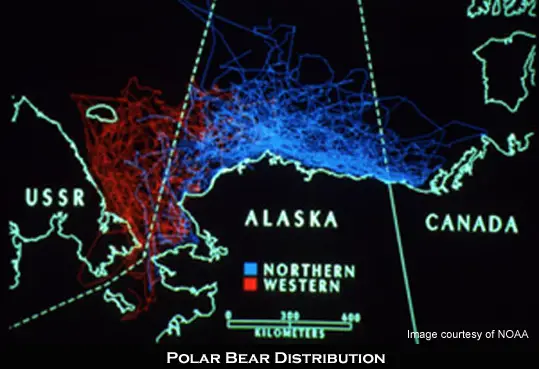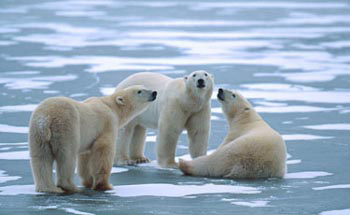Polar bears range throughout the Arctic in areas where they can hunt seals with relative ease. The five “polar bear nations” where the ice bears are found include the United States (Alaska), Canada, Russia, Denmark (Greenland), and Norway. These large animals are the world’s largest land predators and they top the food chain in the Arctic, where they prey primarily on seals. Adult males weigh from 350kgs (775 lbs) to more than 680kgs (1,500 lbs). Females are considerably smaller, normally weighing 150 – 250kgs (330 to 550 lbs). These animals do not reach the maximum size until they are 8-14 years old.

The number of cubs per litter is one or two, rarely three. Younger and older females often have only one cub, while 2 or even 3 cubs may be born to females between the ages of about 8 and 20. As for all mammals, the mortality of cubs is quite high, sometimes exceeding 70%. Cubs typically stay with their mother for 2.5 years, but in some areas where the marine ecosystem is less productive they may remain with their mothers for 3.5 and even 4.5 years. In Western Hudson Bay, variable numbers of cubs may be successfully weaned as yearlings. This means that in most parts of their range, females normally mate and gives birth every 3 years.
Both males and females become sexually mature around 4-5 years of age. Females normally give birth at sexual maturity, but it is unlikely that males mate before they are 8-10 years old.

New analysis from scientists at the National Center for Atmospheric Research and the National Snow and Ice Data Center (NSIDC), shows that ice in the Arctic is reducing at a rate around 7.8 percent per decade (1953-2006). At this rate, the Arctic Ocean sea ice will disappear by 2060, sooner if the warming rate escalates.
The bears can swim steadily for many hours in order to get from one piece of ice to another. Some individual bears have been recorded swimming about 100 km or so, but they are likely capable of swimming much further if necessary. However, if there is no ice, they have no home. Since these animals depend on sea ice to hunt, breed and travel, the loss of ice is an obvious threat to their survival.
The changing climate and thinning of sea ice has already reduced by a couple weeks the time mother bears have to feed, and build the fat that enables them to sustain themselves and feed their young.
It is estimated that there are about 20,000 to 25,000 polar bears in the wild today, and about 60% live in Canada. With so few numbers, polar bears were listed for the first time in May 2006 in the International Union for Conservation of Nature and Natural Resources (IUCN) Red List of Threatened Species as a threatened species. It has been given the category of “Vulnerable”, which is one of three categories for being threatened; critically endangered, endangered and vulnerable. Read more about these categories at the IUCN Redlist.
These animals are a keystone species in ice-covered Arctic marine ecosystems and alterations to the distribution, density or abundance of this top predator will likely have impacts throughout the arctic ecosystem. There is little doubt that polar bears and other ice-inhabiting marine mammals in the Arctic, are being, or will be, negatively affected by the effects of climate change via changes to their habitats.
|
Other Species Impacted Upon by Climate Change
Quiver Tree |
